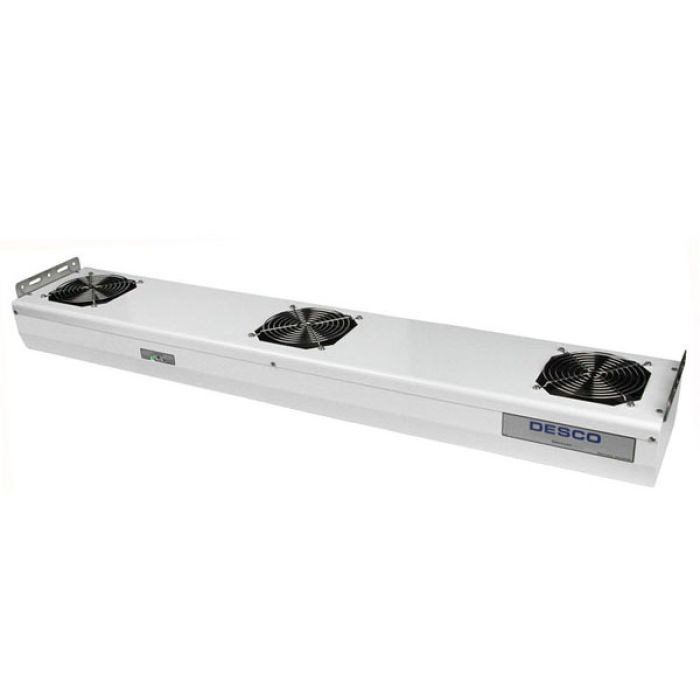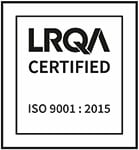
Chargebuster® 3-Fan Overhead Ionizing Blower, 120V
Desco Chargebuster® Overhead Ionizers are steady-state DC ionizers designed for use in ESD protected areas. 3-fan ionizers have a 2.0' x 5.0' coverage area. The Chargebuster® Overhead Ionizers' discharge times (< 3.0 seconds at 18") and low offset voltage (±10 volts) meet the required limits of ANSI/ESD S20.20 < ±35 volts tested per ANSI/ESD STM3.1 and ESD TR53. Its emitters are made of pure tungsten and spaced further apart to minimize ion recombination, increase discharge efficiency and provide a broader coverage area. The fans have 3-speeds (high, medium, low) which produce consistent performance at all 3-settings. The Chargebuster® Overhead Ionizers utilize an auto-feedback system that continuously optimizes its performance and automatically alarms and shuts down should its supply voltage drop.
Packaging Includes
- Chargebuster® Overhead Ionizer
- Hanging Kit
- Power Cord, North American Plug
- 3 Emitter Point Cleaners (60473)
- Certificate of Calibration
- Three 3-Blade Fans with Steady State DC Ionization For 2.0' X 5.0' Coverage Area
- Specially designed fan modules create better coverage (2.0' x 5.0') , consistent offset voltage (balance) ±10 Volts, and superior discharge times(<3.0 seconds) tested per ANSI/ESD STM 3.1
- Auto-Feedback System (Audible And Visual Alarm Through Single Tri-Color LED) unit will automatically shut down and alarm if/when supply voltage drops
- 120/220V Input Voltage Selectable unit can be used with 110V or 220V power sources
- 3-Position Fan Speed: Low, Medium, High Ionization performance is consistent at all speeds and allows for use with sensitive applications, such as calibration, test, or repair procedures
- Replaceable Emitter Pins field replaceable emitter pins allow for minimal downtime
- Compatible Ionizer Motion Sensor 60509 activates an ionizer when an operator is present and deactivates when the workstation is vacant to conserve energy and reduce ionizer maintenance
- NIST Calibrated with accepted procedures and standards traceable to the National Institute of Standards and Technology.
- Made in the United States of America
"Necessary non-conductors in the environment cannot lose their electrostatic charge by attachment to ground. Ionization systems provide neutralization of charges on these necessary non-conductive items (circuit board materials and some device packages are examples of necessary non-conductors). Assessment of the ESD hazard created by electrostatic charges on the necessary nonconductors in the work place is required to ensure that appropriate actions are implemented, commensurate with risk to ESDS [ESD sensitive] items". (ANSI/ESDS20.20-2007 Foreword)
"In order to mitigate field-induced CDM [Charged Device Model] damage, the ESD program shall include a plan for the handling of process-required insulators. If the field exceeds 2,000 volts/inch, steps shall be taken to either: A) Separate the insulator from the ESD-sensitive device by a distance of 30 cm (12 inches); or B) Use ionization or other charge mitigating techniques to neutralize the charge." (ANSI/ESDS20.20-2007 section 8.3)
"The primary method of static charge control is direct connection to ground for conductors, static dissipative materials, and personnel. A complete static control program must also deal with isolated conductors that cannot be grounded, insulating materials (e.g., most common plastics), and moving personnel who cannot use wrist or heel straps or ESD control flooring and footwear. Air ionization is not a replacement for grounding methods. It is one component of a complete static control program. Ionizers are used when it is not possible to properly ground everything and as backup to other static control methods. In clean rooms, air ionization may be one of the few methods of static control available." (ESD Handbook TR20.20 Ionization, section 5.3.6.1)
"All ionization devices will require periodic maintenance for proper operation. Maintenance intervals for ionizers vary widely depending on the type of ionization equipment and use environment. Critical clean room uses will generally require more frequent attention. It is important to set-up a routine schedule for ionizer service. Routine service is typically required to meet quality audit requirements." (ESD Handbook TR 20.20 section 5.3.6.7 Maintenance / Cleaning)
Specifications
- Typical positive and negative discharge times (1000V to 100V) measured using ANSI/ESD STM 3.1 are shown in the "Neutralization (Discharge) Times" section. The performance of the ionizer was measured with the unit positioned as shown, with the fan speed on high and without a filter.
- Input Voltage and Frequency: Internally selectable for 100-120 VAC, 50/60 Hz
- Power Consumption: 3-Fan Overhead: 36 W
- Dimensions: 3-Fan Overhead: 3.9" H x 6.6" W x 37.3" L (99 mm x 168 mm x 947 mm)
- Weight: 3-Fan Overhead 10 lbs (4.5 kg)
- Balance (Offset Voltage) at 18": ±10 V typical ±20 V maximum
- Neutralization (Discharge) Time at 18": < 3.0 seconds
- Airflow (three-speed fans): 3-Fan Overhead: 150-300 CFM
- Emitter Points: 0.050" diameter tungsten
- Ion Emission: Steady-state DC with sense feedback
- Fuse: 400 mA slow blow
- High Voltage Power Supply: 5.5 kVDC nominal
- Ozone: <0.05 ppm
- Enclosure: Powder coated steel
- Mounting Options: Rigid-mounted or suspended from ceiling
- Certifications: CE
| Sell Unit | Each |
|---|---|
| PAC Item Code | I204089 |
| MFG Part Number | 60473 |
| Brand | Desco |
| Input | 120V |


